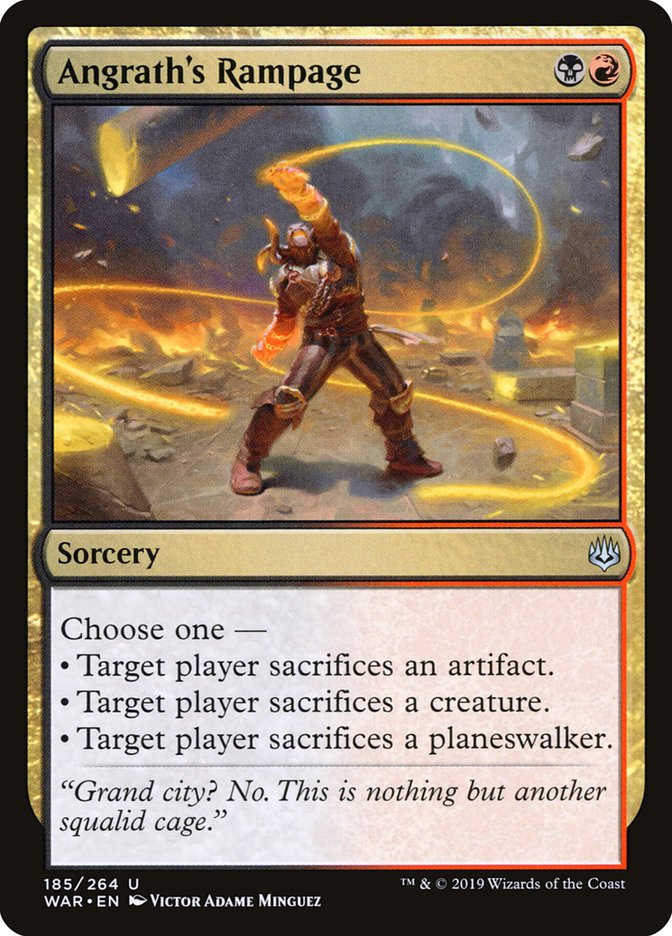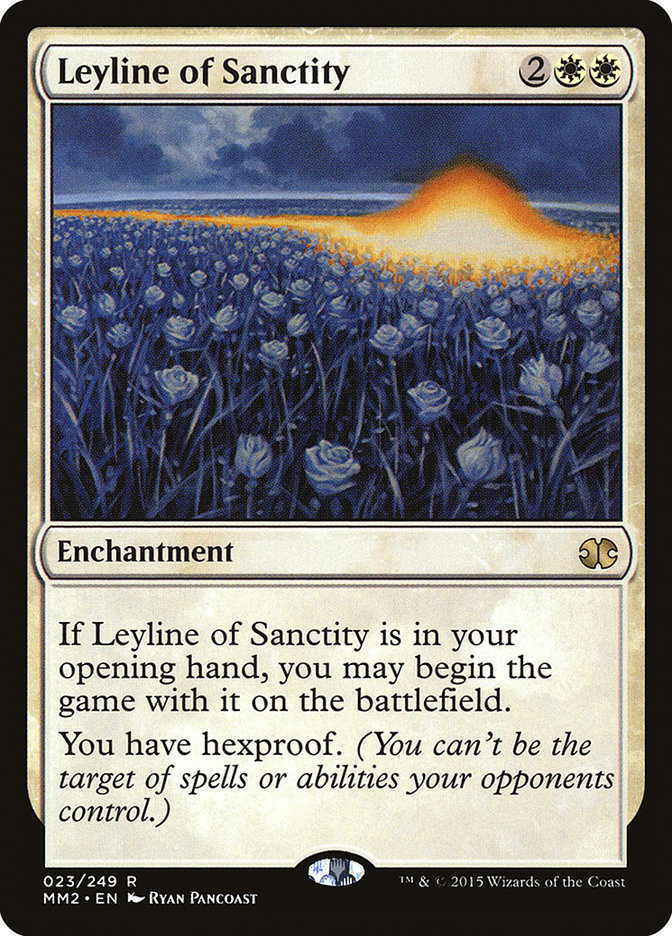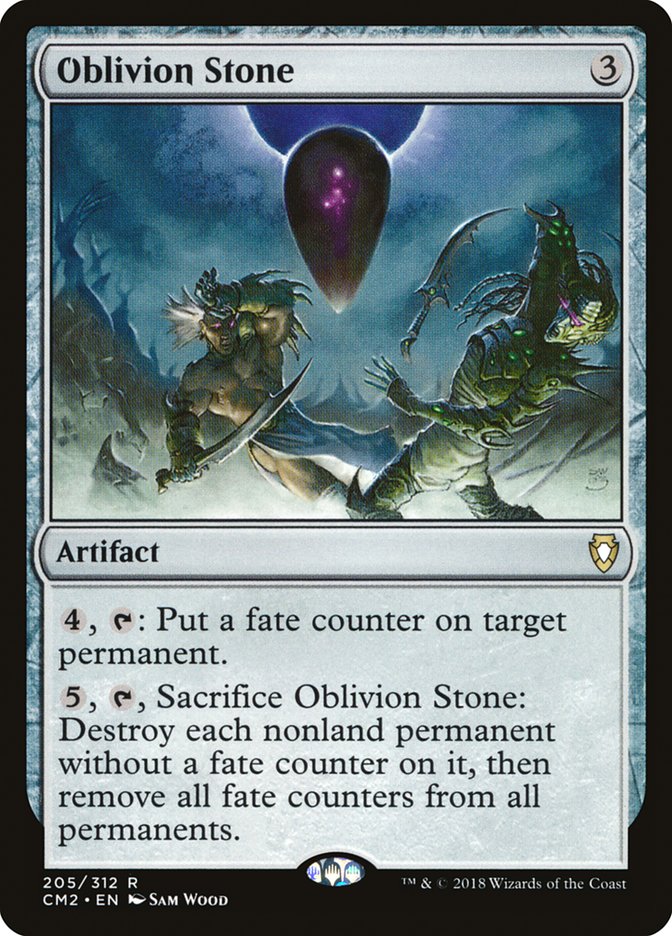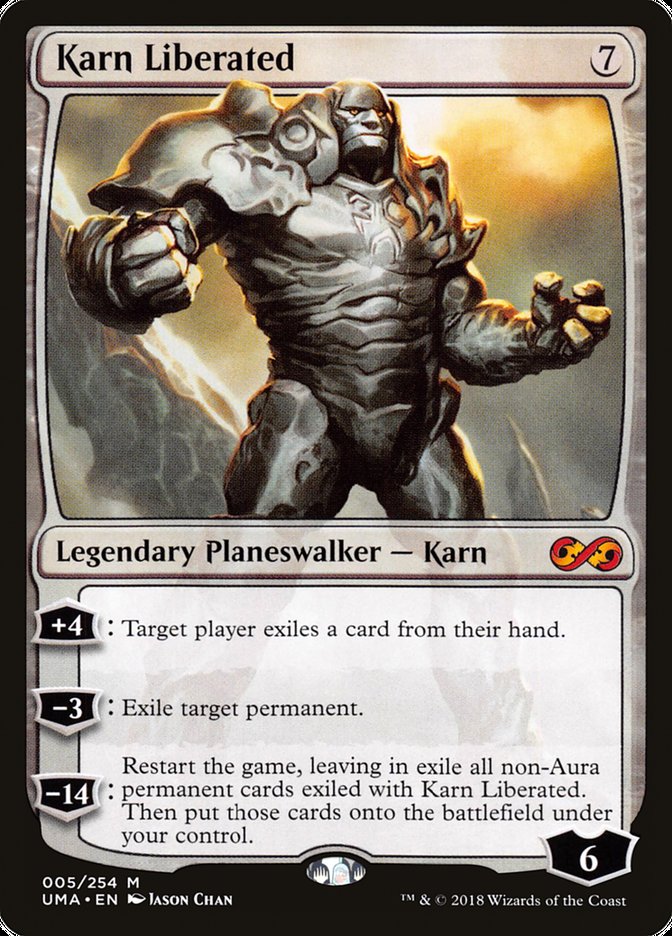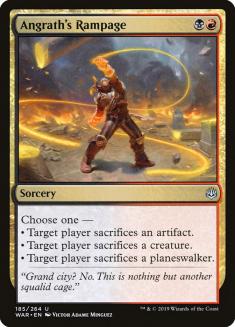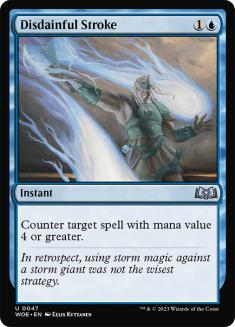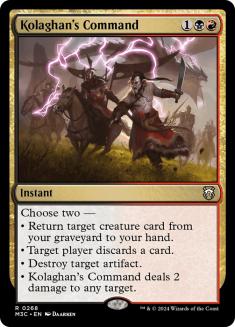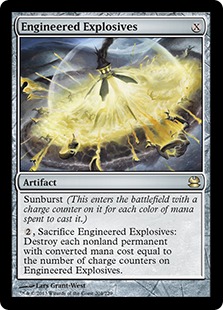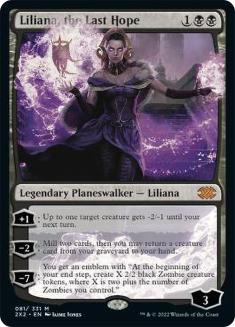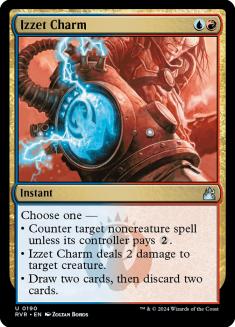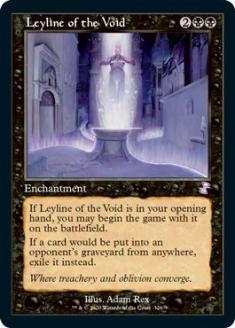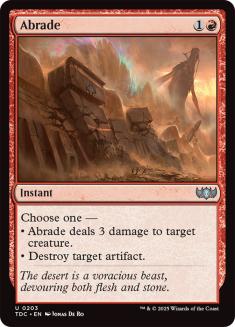Last week, I gushed about Liliana’s Triumph and how pleased I was to see Wizards of the Coast print better, more flexible, more powerful answers as the pendulum of card design goodies seems poised to swing away from threats for the first time in years.
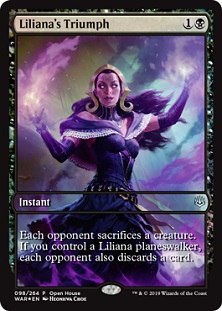
Liliana’s Triumph offers us a significantly better Diabolic Edict, an effect that has been sorely lacking in Modern from its inception. Sure, there are a few players who love to cast Slippery Bogle, but the rest of us would prefer to not have to contort our decks in order to have clean answers to that particular deck. Along with Etched Champion and Auriok Champion, now a whole class of threats actually has some maindeckable counterplay, and in deck design we can square away certain pesky matchups off the bat.
But WotC didn’t stop at improving Diabolic Edict. No, they gave us one of my favorite things in the world. Options. We aren’t stuck playing Liliana’s Triumph, which would be fine by me. We can play Angrath’s Rampage instead.
Angrath’s Rampage is a Cruel Edict, not a Diabolic Edict, but it also hits two annoying and sticky permanent types: planeswalkers and artifacts. Now we get to hem and haw and decide which card we’d rather play (in decks with access to black and red mana; without red mana we’ll be playing Triumph).
We also get to decide if we’d like to cut certain weaker cards from Jund or Grixis decks in order to accommodate this awesome new answer. I know Assassin’s Trophy has a drawback that makes me retch at times, and if you don’t desperately need answers to enchantments or lands, Angrath’s Rampage offers nearly the flexibility of the Trophy without the hefty cost of spotting the opponent a Rampant Growth.
When do you want Angrath’s Rampage, and when do you want Liliana’s Triumph? Why might you choose one over the other?
1. Instant Speed Matters
I don’t need to restate the obvious. Last week, we discussed the incredible benefit that comes from being able to draw-step a Liliana’s Triumph to cut off a topdeck. Against Humans, I would be confident in the post-sideboard matchup with two Liliana, the Last Hope and two Liliana’s Triumph. Snagging the Thalia’s Lieutenant off the top while knocking out a random threat is almost too much value to bear. And of course, there’s the benefit of being able to hold up a Triumph to answer a threat before untapping on a more contained battlefield.
In Legacy, the sorcery speed of Angrath’s Rampage is simply too much of a cost and shuts down the thought of playing Angrath’s Rampage before we give it any real consideration. End-step Marit Lage is a very common play pattern, and we won’t die with a sorcery-speed Edict in our hands. To be fair, my favorite Legacy deck is straight Dimir right now, so this isn’t as much of a concern, but it still matters for Grixis Delver and Grixis Control.
Modern is a far trickier beast with a number of confounding factors, and that’s what makes this type of pro-con debate so interesting.
2. Chalice of the Void
It might be the least fun card in all of Magic. It’s certainly been the fodder for many a nightmare, right up there with the classic “forgot my deck at the Pro Tour” that leaves me gasping in a cold sweat. Losing a game to Chalice is up there with triple-mulligan no-landers and just losing. It might be even more frustrating, because you feel compelled to keep playing. After all, the opponent might miss their trigger, right?
The more cards I have in my deck that can destroy a Chalice of the Void on one, the happier I am. I love Abrade, Ratchet Bomb, and Engineered Explosives for this reason. I insist on a minimum of four ways to hit a resolved Chalice of the Void in my Modern Grixis Death’s Shadow list, and three in my Legacy Dimir list. If I can stuff five or even six ways to remove an offending artifact, I’m going to be a very happy Death’s Shadow player.
Obviously in Modern, Ensnaring Bridge goes right along with Chalice of the Void in a number of extremely irksome situations, and any way to interact with Prison-style decks is very welcome. Unfortunately, the Whir Prison and Lantern Control decks generally will have an abundance of artifacts to sacrifice to an Angrath’s Rampage, though those same decks will generally also have a Welding Jar to save the Chalice of the Void or Ensnaring Bridge from an Abrade or Kolaghan’s Command. It still doesn’t change the fact that a higher density of artifact-related interaction is always better against these irritating lockdown permanents.
3. Planeswalkers
It doesn’t take a genius to recognize that Liliana of the Veil is a problematic card for Grixis Death’s Shadow. Jace, the Mind Sculptor and Teferi, Hero of Dominaria both also win the game if they stick around on the battlefield for more than a turn. Primarily against Golgari and Jund, Angrath’s Rampage offers an answer for Tarmogoyfs, Scavenging Oozes, and Dark Confidants while also handling the one card that leads to more losses than any other. I love positioning myself as a control deck against these midrange strategies, but if a Liliana sneaks through, it’s often game over. Additional density of removal that also hits the most troublesome card in the deck means that Grixis Death’s Shadow players shouldn’t have any reason to fear this matchup.
In the mirror match, some folks still have a Liliana of the Veil to sideboard in, but more than that, there are copies of Liliana, the Last Hope and (now) Jace, Telepath Unbound cluttering the battlefield. A clean answer to those permanents means that it will be harder to stick an unanswerable permanent and leverage it to run away with the game. Get grindy, people! Snapcaster Mage is looking especially appealing right now.
Additionally, various Jeskai and Azorius Control decks occasionally try to win the game with Vendilion Clique or Geist of Saint Traft, which means that having coverage for these threats is an important piece of the puzzle. It feels incredibly relieving to get to play a card that does double coverage of Jace or Teferi alongside Vendilion or Geist, though the lack of instant speed means that Celestial Colonnade is still free to wreak havoc against a low life total.
4. Leyline of Sanctity
Yes, it does merit mentioning that Angrath’s Rampage walks into the Leyline of Sanctity that all Selesnya Hexproof players will be bringing in against Thoughtseize decks. Liliana’s Triumph sidesteps this incredibly obvious countermeasure, which is a minor point in favor of the card. Obviously there aren’t a ton of people sleeving up Slippery Bogle in contemporary Modern, but I would expect to play against the deck once every third or fourth Modern tournament on average. Having Liliana’s Triumph is a slam dunk in the matchup, but it may not be necessary to gain extra percentage there when more coverage of other permanent types is more important.
Overall, this isn’t a big part of the calculus we use when deciding which answer deserves the slot in Grixis Death’s Shadow and Jund Midrange, but it shouldn’t be completely overlooked.
5. Mono-Green Tron Coverage
I’m not going to sit here and pretend that Angrath’s Rampage is a good card against Mono-Green Tron. It’s not. You need to be proactive and not reactive in the matchup. However, Angrath’s Rampage can hit Relic of Progenitus, Oblivion Stone, Karn Liberated, Thought-Knot Seer, and Expedition Map. Obviously, in a number of situations where you get good use out of Angrath’s Rampage in the matchup, you are still likely to lose because it means your opponent has the initiative.
However, snagging an Oblivion Stone is one of the ways to steal a game where you’re applying a bit of pressure and the opponent needs a turn of breathing room. There is value in taking out a Thragtusk to let your Gurmag Angler keep attacking, and sometimes your opponent will just run dry on threats if you hit their one Karn Liberated and make them discard their Wurmcoil Engine. Should the new London Mulligan become the new standard for Magic, Tron stands to gain in consistency, and any additional way to gain percentage against the matchup is more than welcome.
6. Amulet Titan Coverage
I love, love, love Abrade against Amulet Titan, and Angrath’s Rampage is a great addition for similar reasons. Hitting Amulet of Vigor; Azusa, Lost but Seeking; or Sakura-Tribe Scout is a big game, and cards that flex as creature removal or artifact removal are destined to impress in the matchup. Abrade, of course, is instant-speed and therefore more impressive, but having three or four of this particular type of interaction piece is very welcome. If Burn keeps dropping lower on the metagame rankings, it will become an easy shift to put Angrath’s Rampage over Collective Brutality in our sideboards.
Which Is Better?
I don’t have a perfect verdict for this particular debate right off the bat, but I can say that both Angrath’s Rampage and Liliana’s Triumph will fit right in the Shadow Box, and the decision of how to best use our precious fifteen sideboard slots will only get trickier as these flexible answers come trickling out with every new set. It’s going to be awesome.
If I were forced to make a call right now, I’d play something extremely close to Noah Strasler’s list from the recent Modern Open:
Creatures (17)
Lands (17)
Spells (26)

The maindeck is crisp, but my sideboard would change to look like this:
Again, this is extremely tentative. We’ve got an entire Mythic Championship in London to set the stage for the future metagame, but this is where I’d start.
My new heuristic for adding cards to the Shadow Box is as follows: Basically every one- or two-mana spell with the words “choose one” in Grixis colors is going to make it into the box, and in the new age of answers, that can only mean a very rich set of impressive cards. I look forward to the day when I can confidently run a sideboard of fifteen one-ofs without feeling like I’ve made any sacrifices on power. I don’t even think it’s that far-fetched, given what we’re seeing come out of War of the Spark and with Modern Horizons on deck.
If this is the fruit we are seeing borne in Modern by the trees of Best-of-One Standard on Arena, I can’t help but smile at how WotC played a masterful and elegant game. Increasing the flexibility of Modern’s answer suite while promoting better gameplay in a format that they are constrained to support by the nature of Arena is just genius. The next batch of split cards is going to have some really nice ones, I can feel it!
Now we just need that elusive graveyard hate / creature removal / nonbasic land hate card. Can I get a Spreading Seas with a Tormod’s Crypt ability instead of cantripping on entering the battlefield? Or a Funeral Charm that can exile a graveyard instead of granting swampwalk? With so many disparate linear archetypes in Modern, the possibilities are endless!


